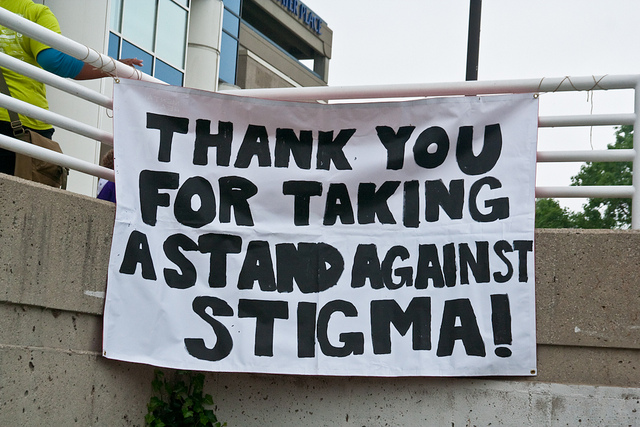Positive signs promote stigma-free zone
You know those little signs you see around town that are attached to bigger signs? Like the Little League signs and the Rotary Club signs nailed to larger signs that proclaim the town’s name?
In Paramus, NJ, those little signs inspired a big idea.
The idea is to install signs that read “Stigma-Free Zone.” What they communicate is a commitment to eliminating the stigma associated with mental illness.

Grand Rapids held an event to “Stomp Out Stigma.” From Steven Depolo.
In 2013, the community became an official Stigma-Free Zone to inspire a new openness in discussing mental illness. The goals include educating people about mental illness and finding the necessary help for those who suffer. The new signs are meant to promote this initiative.
It all started with the recognition of a crisis in our country. And clearly there is a crisis. We all remember the gunman whose mental illness led him to take innocent lives in Newtown, Connecticut in 2012. We’ll never know why he wasn’t treated beforehand. But is it possible he might have received help to prevent the tragedy if social stigma didn’t figure into decisions about his care?
Robin Williams’ suicide was another shock that called attention to mental illness this past August. According to His daughter’s decision to come forward with a call to “end the stigma” also speaks volumes. Could this tragedy have been prevented, too?
We’ve all heard other stories as well, or personally know someone who suffers from mental illness, like depression or anxiety or bipolar disorder. Are they also affected by the stigma? The Mayo Clinic lists the many ways stigma about mental illness can negatively affect people, including harassment, lack of health insurance coverage, decreased social opportunities, and a reluctance to seek treatment.
None of these are outcomes we would wish on those we care about—or anyone, for that matter. As the Newtown tragedy indicates, putting up barriers to treatment can have consequences for an entire community, a country, the world.
Can a few little signs really impact such a big problem? The Stigma-Free Zone initiative isn’t the first to believe in the power of signs. In every town, there’s evidence that street signs can be used to communicate information and aid travel. There are even those who believe signs can be creatively used to curb violence and inspire joy.
So far, 12 other towns in New Jersey’s Bergen County are in on the Stigma-Free Zone initiative. Suppose a similar snowball effect brings “Stigma-Free Zone” signs into those communities. And suppose when people see those signs, the momentum continues to build, bringing the initiative to more and more states all across the country.
A more positive and pro-active perspective on mental illness could all start with a few little signs.
